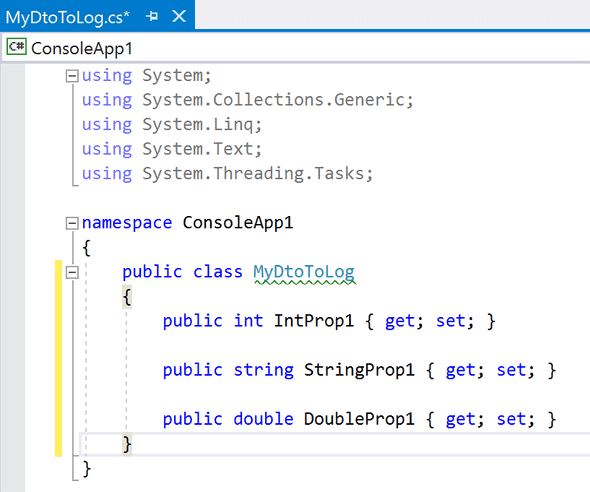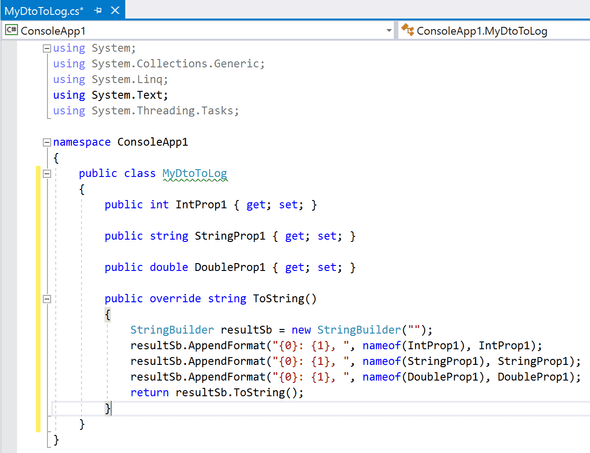I recently had the opportunity to update the quality of logging in an application. Exceptions were handled well, but it was hard to see the values passed through the layers. I ended up using a Roslyn CodeFix to add a ToString method.
Setup
Once you’ve created a new “Analyzer with Code Fix” project, there’s two parts to write:
- The Analyzer – the code that highlights the problem by adding a green squiggly line;
- The CodeFix – the code that runs to “fix” the problem highlighted by the analyzer
The Analyzer
My requirement was straight foreward, “add a ToString method” to a class. Turns out the code created in the new project is almost good enough. It highlights any classes declared with lowercase letters. As I want all classes, we can just change the AnalyzeSymbol method in Analyzer.cs to:
private static void AnalyzeSymbol(SymbolAnalysisContext context)
{
var namedTypeSymbol = (INamedTypeSymbol)context.Symbol;
var diagnostic = Diagnostic.Create(Rule,
namedTypeSymbol.Locations[0],
namedTypeSymbol.Name);
context.ReportDiagnostic(diagnostic);
}That’s it for the analyzer. It passes all Class Declarations to Rosylyn to create a Diagnostic.
If you press F5 now to debug the project, a new instance of Visual Studio will open. This new instance has our analyzer installed. So create a simple console app and you will see all class declarations are decorated with a green squiggly line.

The CodeFix
This is a bit more involved. I didn’t know what I was doing and struggled with the documentation. After some trial and error, this is what I ended up doing:
- Find the class declaration (again, I don’t think the information from the analyzer gets passed across)
- Loop over all the public properties of that class and construct the ToString method
- Add the new ToString method
Find the class declaration
The project sample uses RegisterCodeFixesAsync in the CodeFixProvider.cs file as the entry point. I changed RegisterCodeFixesAsync by first adding:
var classDeclaration = root.DescendantNodes().FirstOrDefault(
node => node is ClassDeclarationSyntax) as ClassDeclarationSyntax;
if (classDeclaration == null) return;And then updating the call to RegisterCodeFix to pass this new classDeclaration variable. The whole method looks like:
public sealed override async Task RegisterCodeFixesAsync(CodeFixContext context)
{
var root = await context.Document
.GetSyntaxRootAsync(context.CancellationToken)
.ConfigureAwait(false);
var diagnostic = context.Diagnostics.First();
var classDeclaration = root.DescendantNodes()
.FirstOrDefault(node => node is ClassDeclarationSyntax)
as ClassDeclarationSyntax;
if (classDeclaration == null) return;
// Register a code action that will invoke the fix.
context.RegisterCodeFix(
CodeAction.Create(
title: title,
createChangedSolution: c =>
MakeUppercaseAsync(context.Document, classDeclaration, c),
equivalenceKey: title),
diagnostic);
}That passes all instances of class declarations to a method called MakeUppercaseAsync. For this example, it is a terrible name, but it’s the one created by the project. Feel free to rename it to something more accurate. I’ve left it to help with cutting and pasting for this post.
Now we’ve found the class declaration, let’s build up the ToString method.
Building the ToString body
To construct the body, we need to find all the properties in the class, loop over them, and create a string that will represent the body.
This gets complicated quickly. We need to write some C#, that will write the C# that makes the ToString method. Confused? I certainly was. I ended up thinking of it as layers on the onion.
The innermost layer of the onion is what’s in the logs. I wanted the log to contain something like IntProp1: 5 for a property called IntProp1 with a value of 5.
The next layer of the onion, is the C# code that you would write to achieve that log format. In this example, it would be something like:
Console.WriteLine("{0}: {1}, ", nameof(IntProp1), IntProp1);The outer layer of the onion is the code we put in the CodeFix. It’s output will be added to the class. It needs to create the C# code, that when ran will output the above Console.WriteLine.
Rather than using lots of Console.WriteLine statements, I decided to use a StringBuilder, but the outcome is the same. I ended up with the following to construct the body of the ToString method:
SyntaxNode root = await document.GetSyntaxRootAsync(cancellationToken)
.ConfigureAwait(false);
var props = root.DescendantNodes().Where(x => x is PropertyDeclarationSyntax);
// Construct the contents of the ToString method
StringBuilder sb = new StringBuilder(@"
StringBuilder resultSb = new StringBuilder("""");
");
foreach (SyntaxNode currentProp in props)
{
var currentSyntax = currentProp as PropertyDeclarationSyntax;
sb.Append("resultSb.AppendFormat(\"{0}: {1}, \", nameof(" +
currentSyntax.Identifier.Value + "), " +
currentSyntax.Identifier.Value + ");");
sb.Append(Environment.NewLine);
}As you can see, this loops over all the descendants of the root node (the class declaration) that are Property Declarations. Then appends to a StringBuilder the format we want.
Putting it all together
My final MakeUppercaseAsync method looked like:
private async Task<Solution> MakeUppercaseAsync(Document document,
ClassDeclarationSyntax classDecl,
CancellationToken cancellationToken)It’s the code above, with some extra helper methods that I found on stack overflow. For this project, just put them at the end of the class, but a helper library would be a better long term choice.
Helper Methods
Credit goes to Nvalchev in this answer on stack overflow for these. They help create method declarations and constructing parameter lists.
public MethodDeclarationSyntax GetMethodDeclarationSyntax(string returnTypeName, string methodName, string body)
{
var syntax = SyntaxFactory.ParseStatement(@"" + body + "return resultSb.ToString();");
var parameterList = SyntaxFactory.ParameterList(SyntaxFactory.SeparatedList(GetParametersList(new string[0], new string[0])));
var modifiers = new SyntaxToken[] { SyntaxFactory.Token(SyntaxKind.PublicKeyword), SyntaxFactory.Token(SyntaxKind.OverrideKeyword) };
return SyntaxFactory.MethodDeclaration(attributeLists: SyntaxFactory.List<AttributeListSyntax>(),
modifiers: SyntaxFactory.TokenList(modifiers),
returnType: SyntaxFactory.ParseTypeName(returnTypeName),
explicitInterfaceSpecifier: null,
identifier: SyntaxFactory.Identifier(methodName),
typeParameterList: null,
parameterList: parameterList,
constraintClauses: SyntaxFactory.List<TypeParameterConstraintClauseSyntax>(),
body: SyntaxFactory.Block(syntax),
semicolonToken: SyntaxFactory.Token(SyntaxKind.SemicolonToken))
// Annotate that this node should be formatted
.WithAdditionalAnnotations(Formatter.Annotation);
}
private IEnumerable<ParameterSyntax> GetParametersList(string[] parameterTypes, string[] paramterNames)
{
for (int i = 0; i < parameterTypes.Length; i++)
{
yield return SyntaxFactory.Parameter(attributeLists: SyntaxFactory.List<AttributeListSyntax>(),
modifiers: SyntaxFactory.TokenList(),
type: SyntaxFactory.ParseTypeName(parameterTypes[i]),
identifier: SyntaxFactory.Identifier(paramterNames[i]),
@default: null);
}
}If you run this code now, and apply the code fix to a class with some properties, it should add a ToString method.

Alternatives
Before winding up this post, I think it’s worth pointing out some other ways of doing it.
My first thought was to use reflection. The idea was to reflect over the objects being logged. I imagine it would’ve worked, but probably isn’t great performance wise.
Then I considered just relying on converting the objects to JSON. This has the advantage of “just working” for every object. And unless you have a good reason not to go down that route, I think it’s a great idea.
Unfortunately, both of those suffer the same problem. They are a bit inflexible and they are both all or nothing. I had some properties that shouldn’t be in the log files. Making sure those weren’t logged is a lot easier when you have a ToString method.
I’m sure there’s a way of using attributes (or something else) to make the other two handle that. But that relies on the dev knowing they are there and it’s too easy for an object to slip through the gaps. Using a ToString method at least makes it explicit.
Finally, there’s always ReSharper!
Conclusions
The solution in this post is far from perfect. There are a number of things that can be improved:
- It doesn’t handle classes that already have a ToString method very well;
- It doesn’t add the required “using” statements;
- It adds an extra semi-colon at the end
- Property type is ignored, Collections, Lists etc is not handled
Despite those issues, it’s already saved me a lot of typing. Also, creating a Roslyn CodeFix to add a ToString method was a good learning experience. Getting started was difficult, but the more I use the features of Roslyn, the more convinced I am that I’ll be doing a lot more in the future.
Let me know if you spot a mistake or an area I can improve on. I’ve uploaded the code so far to GitHub. Feel free to make a PR or raise an issue.
Comments Section